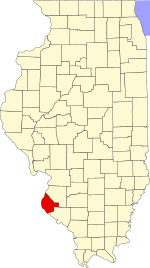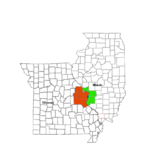
St. Clair County is the ninth most populous county in Illinois. Located directly east of St. Louis, the county is part of the Metro East region of the Greater St. Louis metropolitan area in southern Illinois. As of the 2020 United States census, St. Clair County had a population of 257,400, making it the third most populous county in Illinois outside the Chicago metropolitan area. Belleville is the county’s seat and largest city.

Randolph County is a county located in the U.S. state of Illinois. According to the 2020 census, it had a population of 30,163. Its county seat is Chester.

Columbia is a city mainly in Monroe County with a small portion in St. Clair County in the U.S. state of Illinois, about 12 miles (19 km) south of St. Louis, Missouri. The population was 10,999 at the 2020 census.

Hecker is a village in Monroe County in the U.S state of Illinois. The population was 429 at the 2020 census, down from 481 in 2010.

Valmeyer is a village in Monroe County, Illinois, United States. The population was 1,233 at the 2020 census. It was originally located in the American Bottom floodplain of the Mississippi River but now occupies higher land to the east.
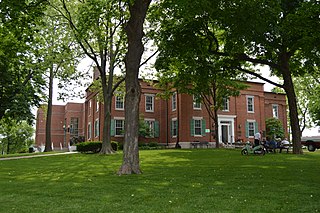
Waterloo is a city in and county seat of Monroe County, Illinois, United States. The population was 11,013 at the 2020 census, up from 9,811 in 2010.

Kaskaskia is a village in Randolph County, Illinois. Having been inhabited by indigenous peoples, it was settled by France as part of the Illinois Country. It was named for the Kaskaskia people. Its population peaked at about 7,000 in the 18th century, when it was a regional center. During the American Revolutionary War, the town, which by then had become an administrative center for the British Province of Quebec, was taken by the Virginia militia during the Illinois campaign. It was designated as the county seat of Illinois County, Virginia, after which it became part of the Northwest Territory in 1787. Kaskaskia was later named as the capital of the United States' Illinois Territory, created on February 3, 1809. In 1818, when Illinois became the 21st U.S. state, the town briefly served as the state's first capital until 1819, when the capital was moved to more centrally located Vandalia.

Prairie du Rocher is a village in Randolph County, Illinois, United States. Founded in the French colonial period in the American Midwest, the community is located near bluffs that flank the east side of the Mississippi River along the floodplain often called the "American Bottom". The population was 502 at the 2020 census.
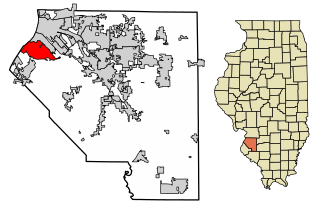
Cahokia is a settlement and former village in St. Clair County, Illinois, United States, founded as a colonial French mission in 1689. Located east of the Mississippi River in the Greater St. Louis metropolitan area, as of the 2010 census, 15,241 people lived in the village. On May 6, 2021, the village was incorporated into the new city of Cahokia Heights.

The Metro East is an urban area in Southern Illinois, United States that contains the eastern and northern suburbs and exurbs of St. Louis, Missouri. It encompasses five counties in the Greater St. Louis area and constitutes the second-most populous urban area in Illinois. The region's most populated city is Belleville, with 42,404 residents.

The American Bottom is the flood plain of the Mississippi River in the Metro East region of Southern Illinois, extending from Alton, Illinois, south to the Kaskaskia River. It is also sometimes called "American Bottoms". The area is about 175 square miles (450 km2), mostly protected from flooding in the 21st century by a levee and drainage canal system. Immediately across the river from St. Louis, Missouri, are industrial and urban areas, but nearby marshland, swamps, and the Horseshoe Lake are reminders of the Bottoms' riparian nature.
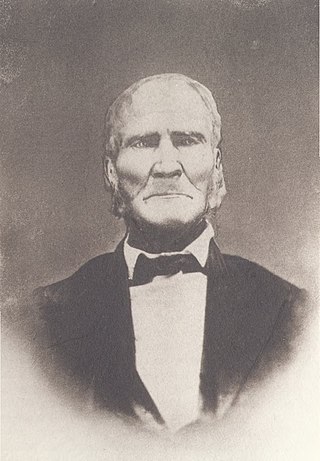
Samuel Whiteside was an Illinois pioneer. A farmer and backwoodsman, Whiteside briefly served in the Illinois General Assembly after statehood and led the Illinois militia for decades, rising to the rank of general but also enlisting as an ordinary soldier when militia calls declined at the end of wars. Whiteside fought the British in the War of 1812 and Native Americans through the Blackhawk War.
The 12th congressional district of Illinois is a congressional district in the southern part of U.S. state of Illinois. It has been represented by Republican Mike Bost since 2015. With a Cook Partisan Voting Index of R+24, it is the most Republican district in Illinois.
Burksville is an unincorporated community in the historic New Design Precinct of Monroe County, Illinois, United States. Originally developed by John P. Brown, Burksville was named in 1857 after John G. Burkhardt, a resident of St. Louis, who opened a store there in 1851. It lies along the old Kaskaskia to St. Louis road off Illinois Route 3, south of Waterloo.
Monroe City is a small unincorporated community in the historic Bluff Precinct of Monroe County, Illinois, United States. As of 2016, the population is approximately 45 people, living in 23 homes. The community is generally considered to comprise the platted towns of Monroe City (1856), Woodville (1857), and the area immediately adjacent to those towns. The core community is located in a valley, or colloquial "hollow," commonly known as the Monroe City Hollow. The central natural feature of the Hollow is the all-season Monroe City Creek. Governmental functions are provided by Monroe County. Electric utilities are provided by the Monroe County Electric Cooperative and public water is offered by the Fountain Water District.
Renault is a small unincorporated community in the historic Renault Precinct of Monroe County, Illinois, United States.
Harrisonville is an unincorporated community in the historic Harrisonville Precinct of Monroe County, Illinois.
St. Joe, Illinois is a small unincorporated community in the historic New Design Precinct of Monroe County, Illinois, United States. It is located along the historic road from Kaskaskia to St. Louis, between Renault and Burksville.
Chaflin Bridge is an unincorporated community in the historic Mitchie Precinct of Monroe County, Illinois, United States. It lies on the old Bluff Road in the American Bottoms between Fults and the old site of Valmeyer and near Maeystown.
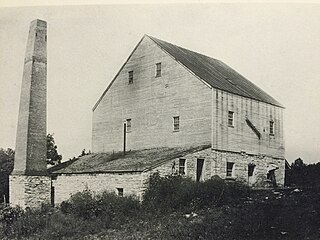
The Monroe City Mill was a grist mill located in Monroe City, Illinois, an unincorporated community in the historic Bluff Precinct of Monroe County, Illinois, United States. Monroe County was founded in 1816. Prior to that, the area was part of St. Clair County in the Illinois Territory.

